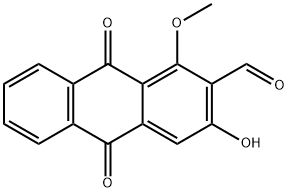477-84-9
 477-84-9 結(jié)構(gòu)式
477-84-9 結(jié)構(gòu)式
基本信息
丹拿堪索
3-羥基-1-甲氧基-2-蒽醌甲醛
DAMNACANTHAL
3-HYDROXY-1-METHOXYANTHRAQUINONE-2-ALDEHYDE
1-Methoxy-2-formyl-3-hydroxy-9,10-anthraquinone
3-Hydroxy-1-Methoxy-2-anthraquinonecarboxaldehyde
1-Methoxy-3-hydroxy-9,10-dioxoanthracene-2-carbaldehyde
3-hydroxy-1-methoxy-9,10-dioxoanthracene-2-carbaldehyde
3-hydroxy-1-methoxy-9,10-dioxo-anthracene-2-carbaldehyde
3-hydroxy-9,10-diketo-1-methoxy-anthracene-2-carbaldehyde
9,10-Dihydro-3-hydroxy-1-Methoxy-9,10-dioxo-2-anthraldehyde
物理化學(xué)性質(zhì)
常見問題列表
IC50: 46 nM (p56
lck
autophosphorylation) and 220 nM (phosphorylation of exogenous substrates by p56
lck
);
Apoptosis;
Candida albicans
Damnacanthal has > 100-fold selectivity for p56
lck
over the serine/threonine kinases, protein kinase A and protein kinase C, and > 40-fold selectivity for p56
lck
over four receptor tyrosine kinases. Damnacanthal also demonstrates modest (7-20-fold), but highly statistically significant, selectivity for p56
lck
over the homologous enzymes p60
src
and p59
fyn
.
Damnacanthal (0.1-100 μM; 1-4 days; HCT-116 and SW480 cells) treatment results in a significant reduction of cell proliferation in a concentration- and time-dependent manner.
Damnacanthal (1-50 μM; 72 hours; HCT-116 cells) treatment results in a significant enrichment in the number of cells in the S/G1 and G2/G1 phases at concentration of 50 μM.
Damnacanthal (10 μM; 24 hours; HCT-116 cells) treatment significantly increases caspase 3/7 activity. Damnacanthal-induced apoptosis.
Damnacanthal (0.1-10 μM; 24 hours; HCT-116 cells) treatment induces NAG-1 expression in HCT-116 cells. Cyclin D1 expression is reduced at 10 μM of Damnacanthal, whereas p21 and p53 does not alter their expression. PARP cleavage is seen at 10 μM Damnacanthal treatment only in HCT-116 cells, where NAG-1 is induced.
Damnacanthal treatment for 2 weeks shows significant decreasing colony number in HCT-116 cells in a concentration-dependent manner. Damnacanthal-treated cells show a dramatic inhibition of clonogenic capacity. Damnacanthal-treated (1-50 μM; 48 hours) cells significantly inhibits the migration of HCT-116 cells in a concentration-dependent manner.
Cell Proliferation Assay
| Cell Line: | HCT-116 and SW480 cells |
| Concentration: | 0.1 μM, 1 μM, 10 μM, 100 μM |
| Incubation Time: | 1, 2, and 4 days |
| Result: | Resulted in a significant reduction of cell proliferation in a concentration- and time-dependent manner. |
Cell Cycle Analysis
| Cell Line: | HCT-116 cells |
| Concentration: | 1 μM, 10 μM and 50 μM |
| Incubation Time: | 72 hours |
| Result: | Resulted in a significant enrichment in the number of cells in the S/G1 and G2/G1 phases at concentration of 50 μM. |
Apoptosis Analysis
| Cell Line: | HCT-116 cells |
| Concentration: | 10 μM |
| Incubation Time: | 24 hours |
| Result: | Significantly increased caspase 3/7 activity. |
Western Blot Analysis
| Cell Line: | HCT-116 cells |
| Concentration: | 0.1 μM, 1 μM and 10 μM |
| Incubation Time: | 24 hours |
| Result: | NAG-1 was induced in HCT-116 cells in a dose- and time-dependent manner. Cyclin D1 expression was reduced at 10 μM. |
Damnacanthal (10-100 mg/kg; oral administration; for 10-300 minutes; male ddY mice) treatment exhibits a significant antinociceptive effect in a dose-dependent manner in the formalin test. Administration of damnacanthal (100 mg/kg) shows significant inhibition of histamine-induced paw edema.
| Animal Model: | Male ddY mice (5-6 weeks) injected with formalin or Histamine |
| Dosage: | 10 mg/kg, 30 mg/kg and 100 mg/kg |
| Administration: | Oral administration; for 10 minutes, 30 minutes, 60 minutes or 300 minutes |
| Result: | Significantly reduced the growth of human lung tumor without acute toxicity. |
